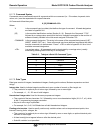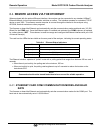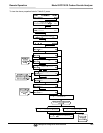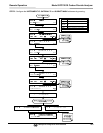
Remote Operation Model GFC7001E Carbon Dioxide Analyzer
Teledyne Analytical Instruments 165
8.4.2. CONFIGURING THE ETHERNET INTERFACE OPTION USING DHCP
The Ethernet option for you GFC 7001E/EM uses Dynamic Host Configuration Protocol (DHCP) to configure its
interface with your LAN automatically. This requires your network servers also be running DHCP. The analyzer
will do this the first time you turn the instrument on after it has been physically connected to your network. Once
the instrument is connected and turned on, it will appear as an active device on your network without any extra
set up steps or lengthy procedures.
NOTE
It is a good idea to check the INET settings the first time you power up your analyzer after it has been
physically connected to the LAN/Internet to make sure that the DHCP has successfully downloaded the
appropriate information from you network server(s).
The Ethernet configuration properties are viewable via the analyzer’s front panel.
Table 8-5: LAN/Internet Configuration Properties
PROPERTY DEFAULT STATE DESCRIPTION
DHCP STATUS
On Editable
This displays whether the DHCP is turned ON or OFF.
INSTRUMENT
IP ADDRESS
Configured by
DHCP
EDIT key
disabled when
DHCP is ON
This string of four packets of 1 to 3 numbers each (e.g.
192.168.76.55.) is the address of the analyzer itself.
GATEWAY IP
ADDRESS
Configured by
DHCP
EDIT key
disabled when
DHCP is ON
A string of numbers very similar to the Instrument IP address
(e.g. 192.168.76.1.) that is the address of the computer used by
your LAN to access the Internet.
SUBNET MASK
Configured by
DHCP
EDIT key
disabled when
DHCP is ON
Also, a string of four packets of 1 to 3 numbers each (e.g.
255.255.252.0) that defines that identifies the LAN to which the
device is connected.
All addressable devices and computers on a LAN must have the
same subnet mask. Any transmissions sent devices with
different subnet masks are assumed to be outside of the LAN
and are routed through a different gateway computer onto the
Internet.
TCP PORT1
1
3000
Editable, but
DO NOT
CHANGE
TSP listening port 1. This port is used for standard Ethernet
communications. The number defines the terminal control port
by which the instrument is addressed by terminal emulation
software, such as Teledyne’s APICOM.
TCP PORT2
1
520
Editable, but
DO NOT
CHANGE
TSP listening port 2. This port is reserved for the GFC
7001E/EM Analyzer’s optional Modbus
®
capability. The number
matches the default address specified by Modbus
®
specifications.
HOST NAME
DEFAULT =
Model Type
Editable
The name by which your analyzer appears when addressed by
other computers on the LAN or via the Internet. While the
default setting is the model type
(e.g. GFC 7001E, etc.) the
host name may be changed to fit customer needs.
ONLINE ON
Editable
Enables or disables the GFC 7001E/EM Analyzer’s two TCP
Ports. The TCP ports are inactive when this is set to OFF.
1
DO NOT CHANGE the setting for this property unless instructed to by Teledyne’s Customer Service personnel.
NOTE
If the gateway IP, instrument IP and the subnet mask are all zeroes (e.g. “0.0.0.0”), the DCHP was not
successful in which case you may have to configure the analyzer’s Ethernet properties manually.
See your network administrator.


















